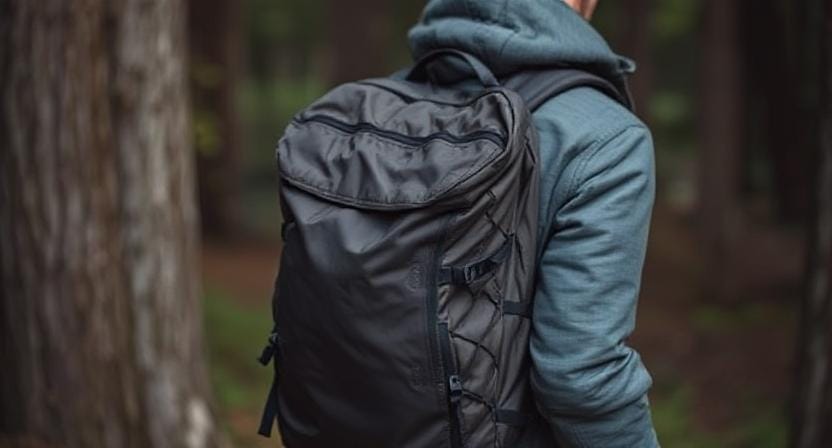Please Note: This post may contain affiliate links. If you click one of them, we may receive a commission at no extra cost to you. As an Amazon Associate, I earn from qualifying purchases.
Top Takeaways and Key Concepts
- Pack only essentials and remove unnecessary items to reduce weight and increase comfort.
- Choose multi-purpose lightweight gear to save space and avoid overpacking.
- Organize strategically using bags and weight distribution for easy access and balance.
- Plan simple lightweight meals and snacks to maintain energy without adding bulk.
- Stay flexible and adapt plans to changing weather or trail conditions.
Summary of This Article
This article explains how to pack smart and travel lighter when backpacking to make the journey more enjoyable. It highlights the importance of carrying only essential gear, choosing lightweight multi-functional equipment, and keeping your backpack organized for easy access and better stability. It also emphasizes planning compact meals, staying adaptable to unexpected situations, and embracing minimalism to improve mobility and reduce stress on the trail. With thoughtful preparation, backpacking becomes more about the adventure and less about the weight on your shoulders.
Short Video Version of this Article
Doesn’t backpacking sound like a dream? The magnificent vistas and the fresh air. But then you start to climb a mountain, and it hits you. Your backpack feels like it has a lot of bricks in it. Oh no!
We always bring too much stuff, don’t we? We act like we want the universe to throw us every curveball. “Don’t forget the extra socks!” In the meantime, they only make you heavier. Who wants to have wet feet on an adventure? Not me!

Let’s talk about how to pack light. You only need the basics. Think about what you’ll actually utilize. It’s a good idea to put everything out first and then take half of it away. You can always do laundry at the campsite, right? And who needs three coats?
How about a small stove instead of the big one? Or maybe just a means to start a great campfire. You might also look at meals that don’t need to be cooked. Anyone want a granola bar? Fast and delicious!
If you bring a good water filter, you won’t have to carry heavy bottles. Get your water from streams and lakes. So much lighter!
Do you remember how much fun it was to hike and marvel at nature? That’s what we want. Not worrying about a heavy bag. The experience is what makes it fun. More fun with less gear. You will feel so liberated!
The Art of Selection: What to Bring (and What to Leave)

First things first: let’s talk about what you really need. By the way, if you’re thinking about bringing your entire wardrobe, I think we need to have a chat.
When choosing gear, focus on essentials. You’ll want items that serve multiple purposes—like a Swiss Army knife but less likely to stab yourself in the finger during an enthusiastic attempt at opening a can.
Thinking about where you’re going makes a big difference, right? Are you trekking deep into the wild, or just setting up camp in your backyard? If it’s the backyard, go ahead, bring all the pillows. But let’s be honest—your dog will probably take them first! Silly pup.
For real backpacking trips, keep it light. You want clothes that won’t weigh you down. Look for moisture-wicking fabric. They dry super fast. Way better than thinking, “Oops, I forgot my tent!” Nothing like a damp shirt to ruin a hike!
Check your backpack, too. If it doesn’t fit or you’re not sure you’ll need it, maybe leave it at home. Seriously, space is precious. You don’t want to lug around “just-in-case” things. That uphill climb can feel like Everest!
Think of it this way: carry what matters. A good water bottle, snacks you love, a small first-aid kit. That’s your survival. More room for the essentials means more room to enjoy your adventure. You’ll feel lighter, happier, and way more ready to explore!
Embrace Minimalism Like It’s Your New Best Friend

Speaking of minimalism, let’s embrace it wholeheartedly! I mean, who needs three pairs of shoes when two will do? Let’s see… one for hiking and one for lounging around camp should suffice unless you’re planning an impromptu dance party by the fire—which I fully support!
Let’s be real for a second. Sometimes, wearing the same clothes for a few days is just part of the adventure. Nature doesn’t mind if you’re rocking yesterday’s shirt. It doesn’t care! Who knows, the squirrels might even think you look kind of cool while they plan how to sneak in and steal your snacks.
And packing light? It’s a game changer. Say goodbye to those giant bottles of shampoo and conditioner. Instead, grab some travel-sized ones or even better—check out shampoo bars. They’re like magic! Small and easy to carry. Your back will definitely thank you when you’re hiking uphill. Less weight means you can enjoy the views instead of wondering why your bag feels like a boulder.
Remember, your goal is to feel good and unbothered while you’re out exploring. And if having a few less things means more room for snacks, that’s a score! Adventure awaits, and you want to be ready for it, not weighed down. Let’s hit the trail looking good and feeling lighter!
Organize Like You’re Preparing for an Audit

Now comes the fun part: putting your things in order! This step is really important because looking for your granola bars in a messy pile is as fun as treading on Legos with bare feet. Use stuff sacks or ziplock bags to keep everything neat and easy to get to. I know they aren’t pretty, but neither are wet socks!
What a great idea to color-code! It’s like adding some personality to your backpack. Picture yourself reaching for a bright blue bag that says “snacks” on it. So simple! Instead of going through a bunch of bags that say “miscellaneous.” You will feel like a pro at organizing, while your friends will be looking for their forks like they are on a treasure hunt.
You want to be the cool person who knows where everything is. And snacks are very important, right? Who wants to be furious on a hike? Not me.
The way the weight is spread out is just as essential. I’m not kidding. You don’t want to feel like you’re leaning to one side on the trail. Put heavy things close to your back. It makes it easy to carry. Things that are lighter? They can go up or down. This way, you keep your equilibrium and don’t have to deal with those ridiculous times when you fall down hills. Believe me, no one wants to roll like a weird tumbleweed.
Let’s promise to pack intelligently and look attractive while we do it! More enjoyment, less worry. Get ready for an adventure!
Food Choices That Won’t Break Your Back

Let’s talk food because who doesn’t love snacks? Packing food is often where we go wrong; suddenly our backpacks resemble mobile grocery stores rather than efficient packs ready for adventure. Honestly though—a few well-chosen meals can make all the difference.
Dehydrated meals are fantastic options—they’re lightweight and require little prep time besides boiling water (which honestly should be on everyone’s skill list).
Nuts and dried fruits are perfect snacks! Seriously, they’re like little energy boosters that fit right in your pack. You can munch on them while hiking, and they won’t make your bag feel like it’s full of bricks—unless you try to bring 20 pounds of them. Then we might have a problem!
Planning meals is a game changer. It feels nice to know you’ve got enough energy for the day. Think about what you need for each day instead of just tossing random snacks in. Hoping for a miracle while cooking over an open fire is a recipe for disaster. You end up with burnt marshmallows and soggy crackers. Not so gourmet, right?
A little prep goes a long way. Maybe pick out a couple of your favorite recipes. Easy stuff, nothing too fancy. Then get your snacks and meals sorted. This way, you’ll enjoy your time outside without worrying about if you’ll have enough to eat!
Both tasty snacks and thoughtful meals mean more fun on your adventure. Who wants to stress over food when there are forests to wander and stars to count?
Stay Flexible: Plans Change (and So Should You)
The best advice could be to stay flexible. Sometimes, Mother Nature has her own intentions, and they can catch us off guard. One minute it’s sunny, and the next you’re slipping in mud and wondering, “Where did my trail go?”
Being able to change is quite useful. It involves having a few backup plans in case something goes wrong. Plans don’t always have to be set in stone. If it starts to rain, why not trade a hike for a trip to some interesting caves? Caves may be really cool! Also, you won’t get wet, and you might locate some cool rocks.
Changes that come out of nowhere sometimes make for the best adventures. You know those times when your plans go wrong and you end up seeing a beautiful scenery or a secret waterfall? You might think of it as an extra adventure. You can have a lot more fun if you just go with the flow.
Don’t bring too much just in case. That will make you feel heavy and make it tougher to enjoy the fresh things that come up. Being flexible helps you try new things and have fun. And who knows? Instead, you can have humorous anecdotes about how daring you were to explore caves.
Packing light for backpacking is all about strategy, not sacrifice. By choosing essential gear, organizing efficiently, planning lightweight meals, and staying adaptable, you can enjoy greater comfort and freedom on the trail. Smart preparation reduces stress, prevents fatigue, and makes your outdoor adventure more enjoyable from start to finish.
Frequently Asked Questions
How do I decide what to pack for a backpacking trip?
Focus on essential items only and avoid packing “just-in-case” extras. Lay everything out before packing, then remove anything you don’t truly need to reduce weight.
What types of gear help reduce backpack weight?
Choose lightweight, multi-purpose gear such as compact cooking tools, moisture-wicking clothing, and versatile items like a bandana or utility knife.
How can I organize my backpack for better balance?
Distribute weight by placing heavier items near the center of your back and lighter items at the top and bottom, using stuff sacks or bags for quick access.
What food is best to pack for lightweight backpacking?
Pack dehydrated meals, nuts, dried fruits, and simple snacks that provide energy without adding bulk or requiring complicated cooking.
How do I carry enough water without extra weight?
Use a portable water filter or purification tablets so you can refill from streams or lakes instead of carrying multiple heavy bottles.
What if the weather changes unexpectedly during my hike?
Stay flexible and prepared by packing basic layers and lightweight rain gear, and be ready to adjust your route or plans when needed.
Is it okay to wear the same clothes for multiple days?
Yes, rewearing clothing is normal in backpacking. Quick-dry, moisture-wicking fabrics help you stay comfortable while keeping pack weight low.
Suggested Resources:
Backpacking Checklist
https://www.rei.com/learn/expert-advice/backpacking-checklist.html
10 Tips for Packing Light
https://www.backpacker.com/skills/tips-for-packing-light/
How To Pack a Backpack
https://www.outdoorgearlab.com/articles/camping-and-hiking/how-to-pack-a-backpack

Kevin Collier is a seasoned outdoor enthusiast and writer for Trekbug.com, specializing in outdoor adventures, survival strategies, and prepping insights. With a deep love for nature and a commitment to self-sufficiency, Kevin empowers readers to embrace the wilderness confidently. He shares valuable tips, practical techniques, and inspiring stories, helping both novice and experienced adventurers develop essential skills for surviving and thriving in the great outdoors.





